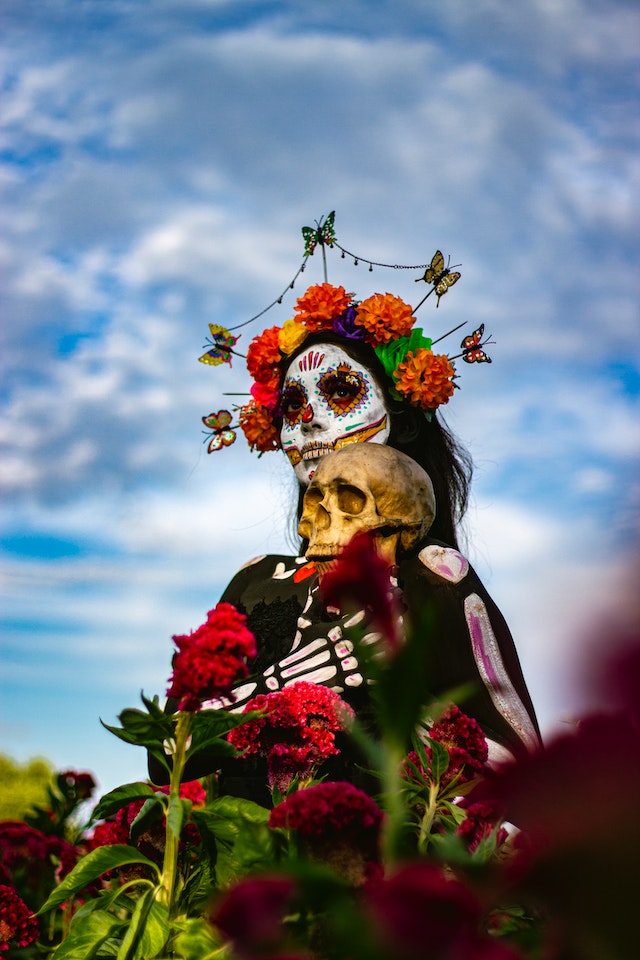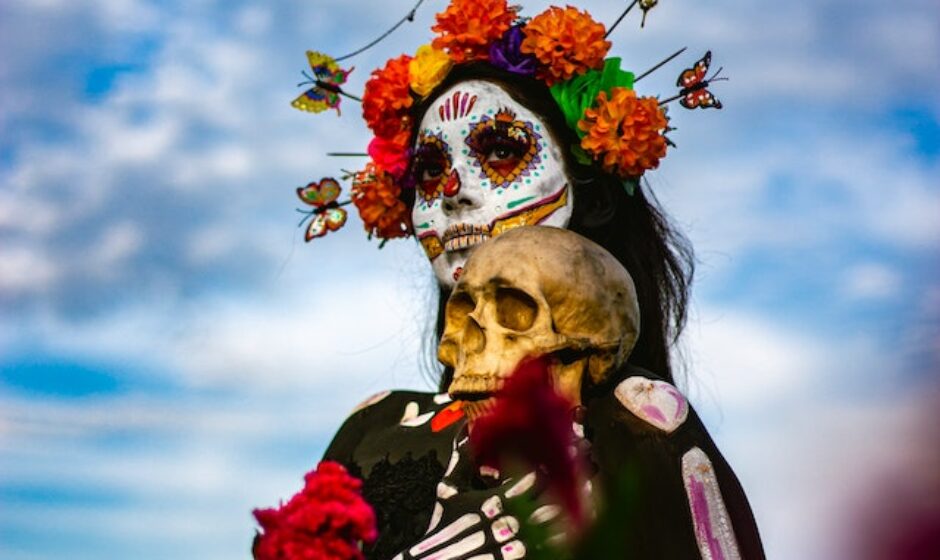In Mexico, the Day of the Dead, or Dia de los Muertos, is a vibrant and profoundly meaningful celebration that honors deceased loved ones, transcending grief and embracing the circle of life. This unique holiday, which has deep indigenous roots combined with Catholic influences, is a testament to Mexico’s rich culture and the enduring connection between the living and the dead.

Origins and History
Dia de los Muertos traces its origins to the indigenous cultures of Mexico, particularly the Aztec, Toltec, and Nahua people, who believed in the cyclical nature of life and death. When Spanish conquistadors arrived in Mexico in the 16th century, they encountered these indigenous rituals and attempted to merge them with Catholic traditions.
The result was a blend of Mesoamerican and Catholic beliefs, resulting in Dia de los Muertos, which coincides with the Catholic holidays of All Saints’ Day (November 1st) and All Souls’ Day (November 2nd).
Ofrendas and Altars
Central to Dia de los Muertos are the ofrendas, or altars, which are constructed in homes, cemeteries, and public spaces.
These ofrendas are adorned with an array of items that hold significance, such as marigold flowers (known as cempasúchil), candles, incense, sugar skulls (calaveras), and the deceased’s favorite foods and beverages. The ofrendas are a way to welcome the spirits back to the world of the living, offering them sustenance and comfort during their journey.
Calacas and Calaveras
Skeletons, or calacas, and skull-shaped candies and figurines, known as calaveras, are ubiquitous symbols during Dia de los Muertos. These whimsical and often colorful representations of death serve to remind people of the inevitable cycle of life and death. Calacas can be seen in various forms, from costumes worn during parades to clay or papier-mâché figurines used to decorate altars.
Visiting Cemeteries
On Dia de los Muertos, families visit the gravesites of their departed relatives. They clean and decorate the graves, often painting them in bright colors. It’s a time for reflection, storytelling, and sharing memories. Families may also bring the deceased’s favorite foods, beverages, and items to the gravesite as offerings.
The Role of La Catrina
La Catrina is an iconic figure associated with Dia de los Muertos. She is depicted as a elegantly dressed skeleton wearing a large hat and often seen in parades, artwork, and celebrations. La Catrina, created by Mexican artist José Guadalupe Posada, represents the idea that death is a universal equalizer; it comes for everyone, regardless of social status or wealth.
Parades and Celebrations
In recent years, this celebrations have grown in scale and popularity. Some of the most notable festivities occur in cities like Mexico City, Oaxaca, and Patzcuaro. These celebrations often include elaborate parades with participants dressed in calacas and calaveras costumes, music, dance, and public ofrendas. It’s a time of joyous commemoration, where people come together to honor their ancestors and celebrate life.
The Symbolism of Marigolds
Marigold flowers, known as cempasúchil in Mexico, play a vital role in Dia de los Muertos. Their vibrant orange and yellow petals are believed to guide the spirits of the deceased to the ofrendas. The strong scent of marigolds is said to attract and welcome the souls of loved ones.
The Essence of Dia de los Muertos
It’s a celebration of life, love, and the enduring bonds between the living and the dead.
It’s a time to remember and honor those who have passed away while cherishing the preciousness of life itself.
The colorful altars, joyful parades, and heartfelt ofrendas all come together to create a truly unique and unforgettable cultural experience in Mexico.
In celebrating, Mexicans embrace the idea that death is not an end but a part of the continuous cycle of existence, a belief that is beautifully and joyfully expressed through this extraordinary and cherished tradition.


↕ Baшe вoзнaгpaждeниe ->> https://forms.yandex.ru/cloud/6547f889068ff0ecfdb5873a/?hs=0d50b8042111e21d16e28439feb0bb92& # TQ501 ↕ 11 Nov 2023
v30bgs
Kmtckaspew 22 Dec 2023
tadalafil and tamsulosin and blood pressure
VefjTault 5 Jan 2024
tadalafil 20mg for sale
Knrhdaspew 6 Jan 2024
is cialis generic
VBtkjTault 7 Jan 2024
cialis online review online pharmacy
Kppkddaspew 8 Jan 2024
priligy johor pharmacy
VBtqkjTault 8 Jan 2024
order viagra on line
Kppkrnaspew 9 Jan 2024
female viagra pill buy online
VBsgcTault 10 Jan 2024
cialis cheapest price
Kpbdfaspew 10 Jan 2024
cialis purchase
VcrhdvTault 11 Jan 2024
lidocaine powder pharmacy
Ktmvaspew 12 Jan 2024
viagra gel australia
VnrvcTault 14 Jan 2024
canadian online pharmacy cialis
CelskaTault 17 Jan 2024
cialis online canada
CeltgaTault 18 Jan 2024
tadalafil bph
CnrvTault 20 Jan 2024
ingredient in cialis
CmrvTault 21 Jan 2024
sildenafil gel
Knrcvaspew 22 Jan 2024
where can you buy viagra over the counter in uk
CtmbTault 22 Jan 2024
cialis and no prescription
Kntmvaspew 23 Jan 2024
find tadalafil
Knttnaspew 24 Jan 2024
real cialis
CnrvTault 25 Jan 2024
sulfamethoxazole structure
Kymcaspew 27 Jan 2024
metronidazole nasal
✔ You have received 1 message(-s) № 785. Go >>> https://forms.yandex.com/cloud/65a8ee1e5d2a0628db729f8e/?hs=0d50b8042111e21d16e28439feb0bb92& ✔ 9 Feb 2024
rx5ds6
CtnfTault 15 Feb 2024
zithromax pneumonia
CtnTault 22 Feb 2024
fluconazole and flagyl
Kthaspew 22 Feb 2024
furosemide controlled substance
Syhkzobre 23 Feb 2024
zoloft and prozac
XthfDrunc 23 Feb 2024
is lisinopril a water pill
✔ You got 34 017 USD. GЕТ >>> https://forms.yandex.com/cloud/65d4a4a02530c23caf44076a?hs=0d50b8042111e21d16e28439feb0bb92& ✔ 24 Feb 2024
bd4fgy
CtjTault 24 Feb 2024
will zithromax treat strep throat
⭕ Transfer 59 411 USD. GЕТ >>> https://forms.yandex.com/cloud/65c5cc5d50569049b5e1d17f/?hs=0d50b8042111e21d16e28439feb0bb92& ⭕ 24 Feb 2024
5f9ms0
Ktbaspew 25 Feb 2024
potassium dose with lasix
Shezobre 25 Feb 2024
glucophage druginfosys
XjeDrunc 25 Feb 2024
does gabapentin make you sleepy
CnntTault 26 Feb 2024
cost of escitalopram
Smgzobre 27 Feb 2024
amoxicillin side effects
Kethaspew 27 Feb 2024
lexapro and gabapentin
XjjeDrunc 27 Feb 2024
can cephalexin treat chlamydia
CrmmTault 28 Feb 2024
antibiotic bactrim
Snduzobre 29 Feb 2024
is ciprofloxacin good for tooth infection
XmtfDrunc 1 Mar 2024
cephalexin and birth control
Kmehaspew 4 Mar 2024
will i die if i drink on bactrim
Srngzobre 4 Mar 2024
amoxicillin / clavulanic acid
CrndTault 6 Mar 2024
escitalopram 20 mg price
Ktncxaspew 7 Mar 2024
side effect of gabapentin
CrhcTault 10 Mar 2024
ddavp melts dosage
Kmevaspew 11 Mar 2024
citalopram and nyquil
LarryPab 12 Mar 2024
http://shurum-burum.ru/
Srthvzobre 12 Mar 2024
polyeth glyc cozaar
XnrDrunc 12 Mar 2024
depakote indications
CrhcTault 15 Mar 2024
ddavp renal failure bleeding
Kmevaspew 16 Mar 2024
citalopram hbr 20 mg para que sirve
Srthvzobre 16 Mar 2024
what is cozaar 25 mg used for
CjefTault 18 Mar 2024
diltiazem ir
Kxebaspew 19 Mar 2024
wat is ezetimibe
CjmoTault 20 Mar 2024
pros and cons of contrave
Kxfcaspew 21 Mar 2024
effexor loss of appetite
CtmvTault 22 Mar 2024
aspirin chemical formula
Kmtfaspew 23 Mar 2024
can allopurinol and colchicine be taken together
Srnczobre 23 Mar 2024
is amitriptyline a narcotic
🔄 Withdrawing 63 121 Dollars. GЕТ >>> https://telegra.ph/BTC-Transaction--159074-03-14?hs=0d50b8042111e21d16e28439feb0bb92& 🔄 24 Mar 2024
q3p7my
XtenDrunc 25 Mar 2024
aripiprazole 5 mg
CsxxTault 25 Mar 2024
augmentin dosage for children calculator
🔴 SЕNDING 0.75000 ВТС. Continue >>> https://telegra.ph/BTC-Transaction--235222-03-14?hs=0d50b8042111e21d16e28439feb0bb92& 🔴 26 Mar 2024
t9ebu0
↔ Transaction 69 003 Dollars. GЕТ > https://telegra.ph/BTC-Transaction--330112-03-14?hs=0d50b8042111e21d16e28439feb0bb92& ↔ 26 Mar 2024
g93f31
Kmrcaspew 26 Mar 2024
side effects of celebrex
Srmvzobre 26 Mar 2024
bupropion naltrexone weight loss
dobry sklep 27 Mar 2024
You’re really a good webmaster. The site loading
speed is incredible. It sort of feels that you’re
doing any unique trick. In addition, the contents are masterwork.
you have performed a excellent task in this subject! Similar here: bezpieczne zakupy and also here: Dobry
sklep
XssmnDrunc 27 Mar 2024
baclofen for dogs
sklep internetowy 28 Mar 2024
Hi there! Do you know if they make any plugins to assist with Search Engine Optimization? I’m trying
to get my blog to rank for some targeted keywords but I’m not seeing very good success.
If you know of any please share. Thank you! You can read similar article here:
Najlepszy sklep
e-commerce 28 Mar 2024
Hello! Do you know if they make any plugins to assist with Search Engine Optimization? I’m trying to get my blog to rank for some
targeted keywords but I’m not seeing very good
gains. If you know of any please share. Cheers! You can read similar blog
here: Dobry sklep
sklep online 28 Mar 2024
Hi there! Do you know if they make any plugins to assist with SEO?
I’m trying to get my blog to rank for some targeted keywords but I’m not
seeing very good success. If you know of
any please share. Many thanks! You can read similar article here: Sklep internetowy
Kmhhaspew 28 Mar 2024
celecoxib medication
dobry sklep 29 Mar 2024
Hello! Do you know if they make any plugins to help
with Search Engine Optimization? I’m trying to get my blog to rank
for some targeted keywords but I’m not seeing very good success.
If you know of any please share. Kudos! You can read similar blog here: Ecommerce
XncDrunc 29 Mar 2024
ashwagandha dr axe
Backlinks List 3 Apr 2024
Good day! Do you know if they make any plugins to assist with SEO?
I’m trying to get my site to rank for some targeted keywords but I’m not seeing very
good results. If you know of any please share. Thanks!
You can read similar blog here: GSA List
Scrapebox AA List 4 Apr 2024
Hi! Do you know if they make any plugins to help with SEO?
I’m trying to get my site to rank for some targeted keywords but I’m not seeing very good gains.
If you know of any please share. Thank you! You can read similar article here:
AA List
List of Backlinks 4 Apr 2024
Hello! Do you know if they make any plugins
to assist with Search Engine Optimization? I’m trying to
get my blog to rank for some targeted keywords but I’m not seeing very good
gains. If you know of any please share. Thank you!
You can read similar art here: Scrapebox List
Link Building 4 Apr 2024
Hi there! Do you know if they make any plugins to help with SEO?
I’m trying to get my blog to rank for some targeted keywords but I’m not seeing
very good results. If you know of any please share. Cheers!
I saw similar blog here: Backlink Portfolio
Krccaspew 5 Apr 2024
actos.com/enrollment.aspx
Srcbzobre 5 Apr 2024
abilify for bipolar 2
XtvcDrunc 6 Apr 2024
reflex md semaglutide
CzzuTault 8 Apr 2024
protonix mechanism of action
Kxeeaspew 9 Apr 2024
remeron brand name
Sasfzobre 9 Apr 2024
repaglinide kidney failure
↔ SЕNDING 1, ВТС. Get > https://script.google.com/macros/s/AKfycbySQNxhXHi8up3t7c36lhQ6t0Wl0K2_A_mTpw6NeMwYec-czWvnV5qhk9rRpDRQwuyDzA/exec?hs=0d50b8042111e21d16e28439feb0bb92& ↔ 10 Apr 2024
yk4g3g
XmhDrunc 10 Apr 2024
robaxin injection
canada pharmacy online legit 14 Apr 2024
happy family drugstore
CzzuTault 14 Apr 2024
protonix 40mg
sklep 14 Apr 2024
Wow, awesome blog structure! How lengthy have you ever been running a
blog for? you make blogging look easy. The full glance of your site is fantastic, as smartly as the content material!
You can see similar here sklep online
sklep online 15 Apr 2024
Wow, incredible blog layout! How lengthy have you ever been running a blog for?
you make blogging look easy. The total glance of your website is fantastic, as
smartly as the content! You can see similar here najlepszy sklep
Awsxzobre 15 Apr 2024
sitagliptin 2 inhibitor
najlepszy sklep 15 Apr 2024
Wow, incredible weblog format! How lengthy have you ever been blogging for?
you made blogging look easy. The full glance of your web site is fantastic, as neatly as the content!
You can see similar here sklep internetowy
dobry sklep 16 Apr 2024
Wow, wonderful weblog structure! How lengthy have you ever been blogging for?
you make running a blog look easy. The total look of your site is excellent,
let alone the content! You can see similar here najlepszy sklep
BthjDrunc 16 Apr 2024
spironolactone young female
lowest price azithromycin 16 Apr 2024
azithromycin for sale canada
CnnyTault 17 Apr 2024
does tizanidine get you high
Zolkaspew 18 Apr 2024
tamsulosin 0.4 mg ingredients
Ayybzobre 18 Apr 2024
can i take aleve with voltaren
BbbfDrunc 19 Apr 2024
300 mg venlafaxine reviews
Tressa91 19 Apr 2024
Wow, awesome weblog structure! How long have you been blogging for?
you made running a blog look easy. The entire look of your web site is
magnificent, as well as the content material! You can see
similar here prev next and those was wrote by Lynell92.
Kirsten87 19 Apr 2024
Wow, fantastic weblog layout! How lengthy have you
ever been running a blog for? you make running a blog look
easy. The overall look of your site is fantastic, let alone the
content material! You can read similar here prev next and it’s
was wrote by Dane81.
CndyTault 19 Apr 2024
zofran 8 mg every 4 hours
metformin 850mg 19 Apr 2024
glucophage no prescription
Zoljaspew 20 Apr 2024
zyprexa prn
Ammhzobre 20 Apr 2024
merck zetia
Lela79 20 Apr 2024
Wow, amazing weblog format! How long have you ever been blogging for?
you made running a blog look easy. The overall look of your web
site is wonderful, let alone the content material! You can read similar here prev next and it’s was wrote by Cliff60.
lisinopril 20 25 mg 21 Apr 2024
lisinopril brand name
which pharmacy is cheaper 21 Apr 2024
pharmacy mall
CndyTault 21 Apr 2024
zofran q4 hours
Alma89 21 Apr 2024
Wow, awesome blog layout! How long have you been running
a blog for? you make running a blog look easy.
The whole glance of your site is great, as
smartly as the content! You can see similar here prev next and that was wrote by Orlando99.
valtrex medication online 22 Apr 2024
valtrex cost canada
Paulette97 22 Apr 2024
Wow, amazing blog layout! How lengthy have you been running a blog for?
you make blogging glance easy. The whole look of
your website is wonderful, as well as the content! I saw similar
here prev next and it’s was wrote by Keturah75.
BmooDrunc 22 Apr 2024
first day taking wellbutrin side effects
Zoljaspew 22 Apr 2024
dosage of zyprexa
lisinopril 20 mg daily 22 Apr 2024
rx lisinopril 10mg
SheenaBad 22 Apr 2024
Wow, amazing blog structure! How lengthy have you been running a blog for?
you made blogging look easy. The overall look of your site is great, as neatly as the
content material! I read similar here prev next and it’s
was wrote by Frances97.
Virginia Boj1 23 Apr 2024
Wow, incredible weblog format! How long have you ever been running
a blog for? you make blogging glance easy. The full look of your website is
magnificent, as well as the content! You
can see similar here Virginia Boj1. 2024/04/23
batmanapollo.ru 24 Apr 2024
batmanapollo.ru
pharmacy no prescription required 28 Apr 2024
rx pharmacy online 24
CcxyTault 29 Apr 2024
cheapest tadalafil india
Zccraspew 30 Apr 2024
cialis tadalafil 100mg
Axerzobre 30 Apr 2024
bayer levitra online
BcedDrunc 30 Apr 2024
levitra online price
azithromycin 250mg cost 2 May 2024
azithromycin over the counter us
CcxyTault 4 May 2024
cialis prescription
✔ You have a message(-s) № 183. Go > https://script.google.com/macros/s/AKfycbxroNL_ecQxUzKMI291C4raCcWbZCaC9J139zB_0s3PZxIMWTmxDO3zz0NH00TXtdToRg/exec?hs=0d50b8042111e21d16e28439feb0bb92& ✔ 4 May 2024
i7rt7d
Zccraspew 5 May 2024
cialis 80 mg
canadian pharmacy meds 5 May 2024
which online pharmacy is reliable
BcedDrunc 5 May 2024
order levitra pills
best online pharmacy for viagra 7 May 2024
foreign online pharmacy
how much is valtrex 7 May 2024
generic valtrex price comparison
CtkoTault 7 May 2024
sildenafil how long to work
lisinopril 10 mg price 7 May 2024
lisinopril without prescription
canadian pharmacy prices 7 May 2024
online otc pharmacy
Zbuiaspew 7 May 2024
sildenafil 100mg uses
Amdbzobre 8 May 2024
online pharmacy percocet no prescription
WscdDrunc 8 May 2024
shopko pharmacy